The pool filter pressure gauge is often a misunderstood and under-appreciated piece of pool equipment. Part of your pool’s main filter tank, it serves a very important function — letting you know the pressure inside your filter tank. The pressure level inside your filter tank indicates how well the filter system is operating.
Many people don’t know that every filter system operates at a different pressure. Your filter may be clean and normal at 9–10 psi, but your neighbor’s filter gauge could run higher, and be clean at 15-16 psi. Some systems with low resistance can run very low pressures, while other filter systems can run quite high, pushing 30 psi when the filter becomes dirty.
Today’s post discusses how to read your filter pressure gauge. Which will help diagnose circulation or filtration problems, and how to know if your pressure gauge is trustworthy. We’ll also talk about the air bleeder assembly, which most filter pressure gauges are screwed into.
What Should the Filter Pressure Gauge Read?
Common question, but each pool filter system has its own “pressure personality,” and there isn’t a singular pressure range that’s correct for all pool filters. If anything could be considered “normal,” it would be about 10 psi. Most filter systems are designed to operate in the 5–15 or 10–20 psi range. The way to find out your filter’s correct pressure range is to clean or backwash the filter thoroughly and empty the pump and skimmer baskets. Start the filter, and when it reaches its full head, note the pressure gauge reading. That is your clean, or starting, pressure. It should never drop lower than that, and if it increases 5–10 psi above that starting pressure, it’s time to clean the filter again.
The pool filter pressure should be steady within this range. When it’s outside this range, either very low or very high, then you’ll know something’s wrong. Some gauges allow you to set the clean and dirty range, or you can write it on the filter tank with a marker.
Types of Pool Filter Pressure Gauges
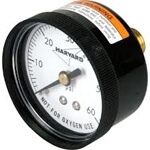
Pool filter pressure gauges are typically a 0–60 psi gauge, with a 1/4″ NPT threaded attachment. The threads can be on the bottom of the gauge (used on top of DE, cartridge, and side mount sand filters), or on the back of the gauge (back mount) for sand filters with the valve on top. A 0–30 psi gauge can also be used for pool filters.
Digital pressure gauges are available, but they are more costly than traditional gauges. In fact, digital gauges can be 10x the cost of traditional analog pressure gauges. Oil-filled pressure gauges with a stainless steel body are more durable than regular gauges with plastic or powder coated steel cases, but they’re not necessary.
Common Filter Pressure Problems
Your filter is one of the most important pieces of pool equipment and is crucial to keeping your pool clean and healthy. A malfunctioning or dirty filter will cause many other pool problems, like cloudy water, algae growth, etc. Below is a list of common pool filter issues and how to resolve them. Remember, always check your filter pressure gauge to determine the overall health and functionality of your pool filter.
Low Pool Filter Pressure
When the pressure is lower than normal, this usually indicates a flow problem before the pump. Something is blocking or restricting water flow into the pool pump. It’s never a problem after the pool pump, because after the impeller, the pool water is under pressure, and obstructions result in higher than normal pressure. It bears repeating: when pool pressure gauge reading is low, look for the problem at the pump or before the pump. These are some common causes of low filter pressure:
- Clogged pump basket or skimmer baskets
- Clogged pump impeller
- Eyeball fittings not in place at pool returns
- Filter valve allowing water to bypass filter
- Air pulling into system at pump intake or pump lid, or valves
- Closed or partially closed skimmer or main drain valves
- Clogged skimmer pipes or main drain cover
- Cracked or collapsed skimmer pipes
High Pool Filter Pressure
When the filter pressure is higher than normal, this also indicates a flow problem. But in this instance, the problem is after the pump, not before. High pressure usually indicates a dirty pool filter, meaning it’s time to backwash or clean the filter cartridge. Be careful with high filter pressure, as filter tanks can rupture with deadly force. Always keep your hand on the switch and your eye on the pressure gauge when starting a pool filter. If you see the pressure begin to rise, shut off the pump immediately, and look for one of these problems below:
- Dirty pool filter
- Closed or partially closed return side valves
- Plugs left in wall, or restrictive eyeball fittings
- Filter media (sand, grids, cartridge) problems
- Broken internal filter valve parts (multiport or push-pull)
- Broken internal filter or heater parts
- Lime deposits inside gas heater heat exchanger
Filter Pressure Gauge is Stuck
A pool pressure gauge that stays in one spot and never fluctuates is concerning. Is it working? Does it go back to zero when you shut off the pump? Is it properly sized? 0-60 psi is the standard pool filter pressure gauge. Some filter systems operate on clean pools with a very small range, and can run for months and only increase a couple psi on the pressure gauge. These filters are generally oversized with smaller pumps, which is a good way to go. If your pressure gauge doesn’t move at all, it might be time to replace it with a new one.
Filter Pressure Gauge is Not Working
If the pressure gauge appears to be hibernating, gently — and we mean gently — tap it with your finger. Shut off the pump if this tried and true method doesn’t work, and the gauge should go to zero. If the gauge stays at zero when you turn the pump on, the air bleeder assembly under the gauge is probably clogged. Remove the gauge and the assembly, and clean out the inner cavity.
If the pressure gauge needle stays in place when you shut off the pump, the dial is likely bent. Metal gauges can become faulty and rust where the pin holds the needle. Plastic gauges can warp in the sunlight, and the face/dial can bend. If your filter pressure gauge is broken, it’s simple to replace. Be sure to use Teflon tape on the threads before screwing it into place.
What is the Filter Pressure Gauge Air Relief Valve?
The air relief valve, also known as the bleeder valve, bleeds trapped air from the pool filter. In practice, it’s meant to be opened after you start the pool pump, to release air trapped at the top of the filter tank. Close the valve knob once the water starts to spray out of the valve.
Filter Pressure Gauge is Stripped
It’s probably not the gauge that’s stripped, but for sand filters with top mounted valves, the gauge screws into plastic threads in the multiport valve housing or body. If the pressure gauge is cross threaded, this can damage the threads. A 1/4″ NPT tap can be used to gently re-cut the threads again, and extra Teflon tape around the pressure gauge threads. If that fails, you can tap it out larger, to 5/16″, and then use a threaded brass insert of the right size. If that fails, you will need to replace the valve body (or the entire valve), if the leak is excessive.
Filter Pressure Gauge is Leaking Water
Rarely do pressure gauges leak water, but they can. Use a 1/4″ pump plug in place of the gauge until you buy a new pressure gauge. Usually the leak of a pressure gauge is actually the air relief assembly leaking water, not the gauge. A leaking air relief valve can often be repaired with Teflon tape, or by replacing a small o-ring on the knob, or by installing a new air relief valve. The old Pac-Fab air bleeder fits many filters. For others, like Hayward filters, visit our parts department to order the correct air bleeder parts for your pool filter.
Taking care of your pool filter will keep your pool clean and healthy. Check the filter pressure gauge often to stay on top of your filter’s cleanliness and efficiency.

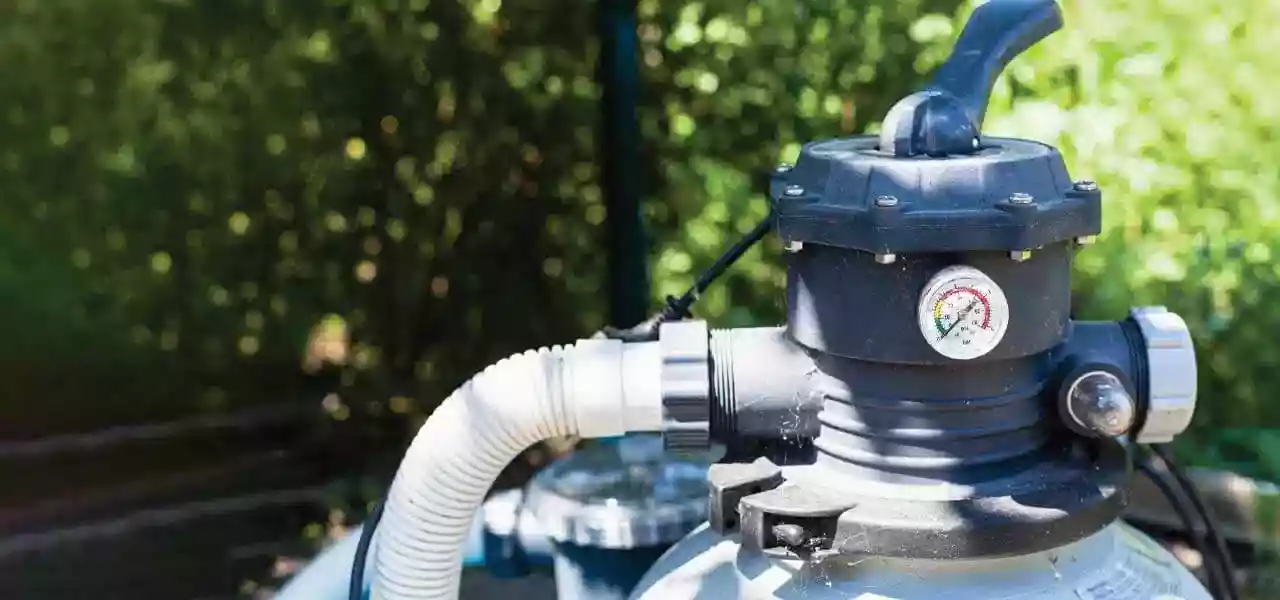

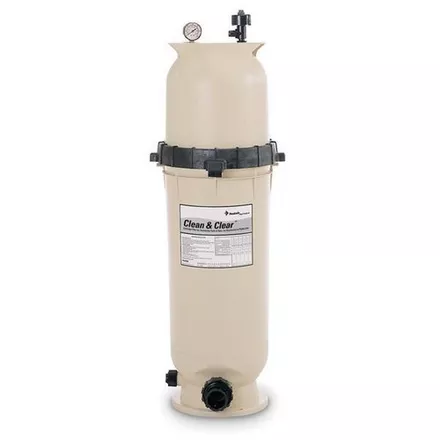
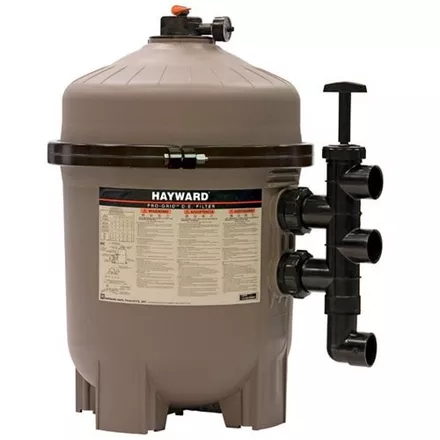
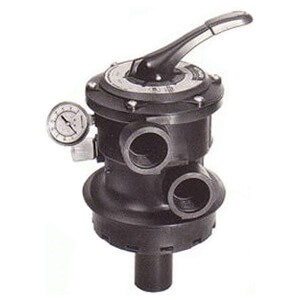
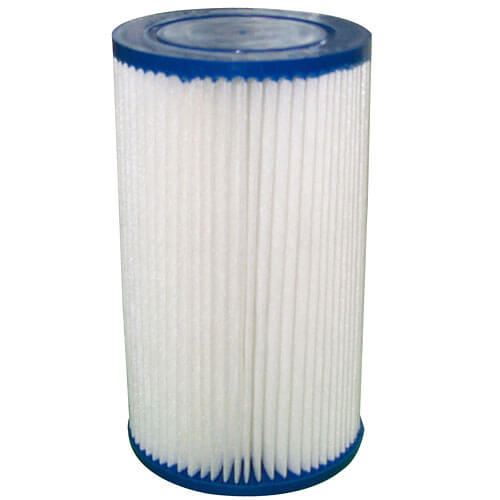
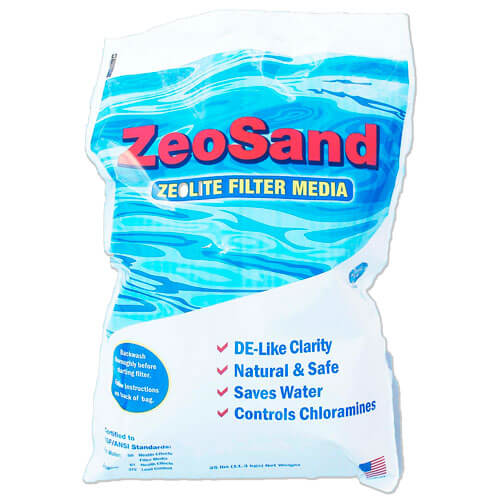
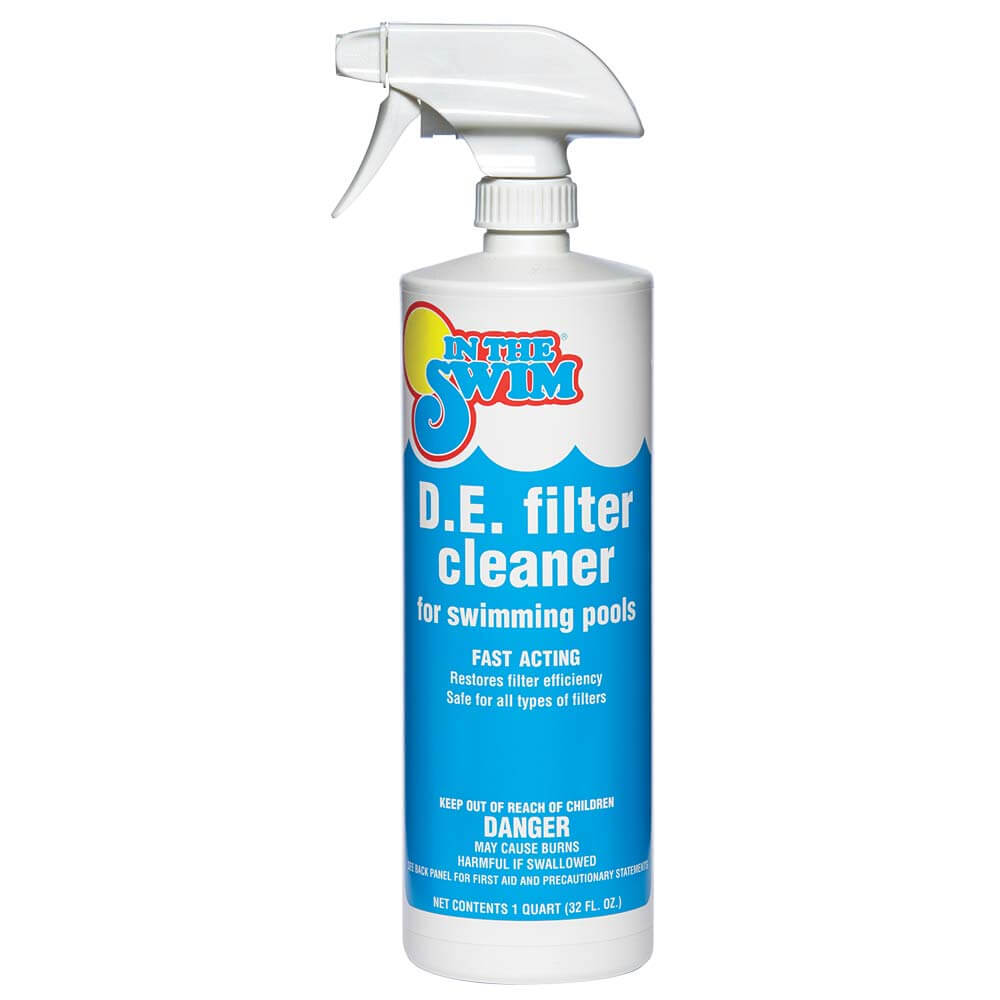
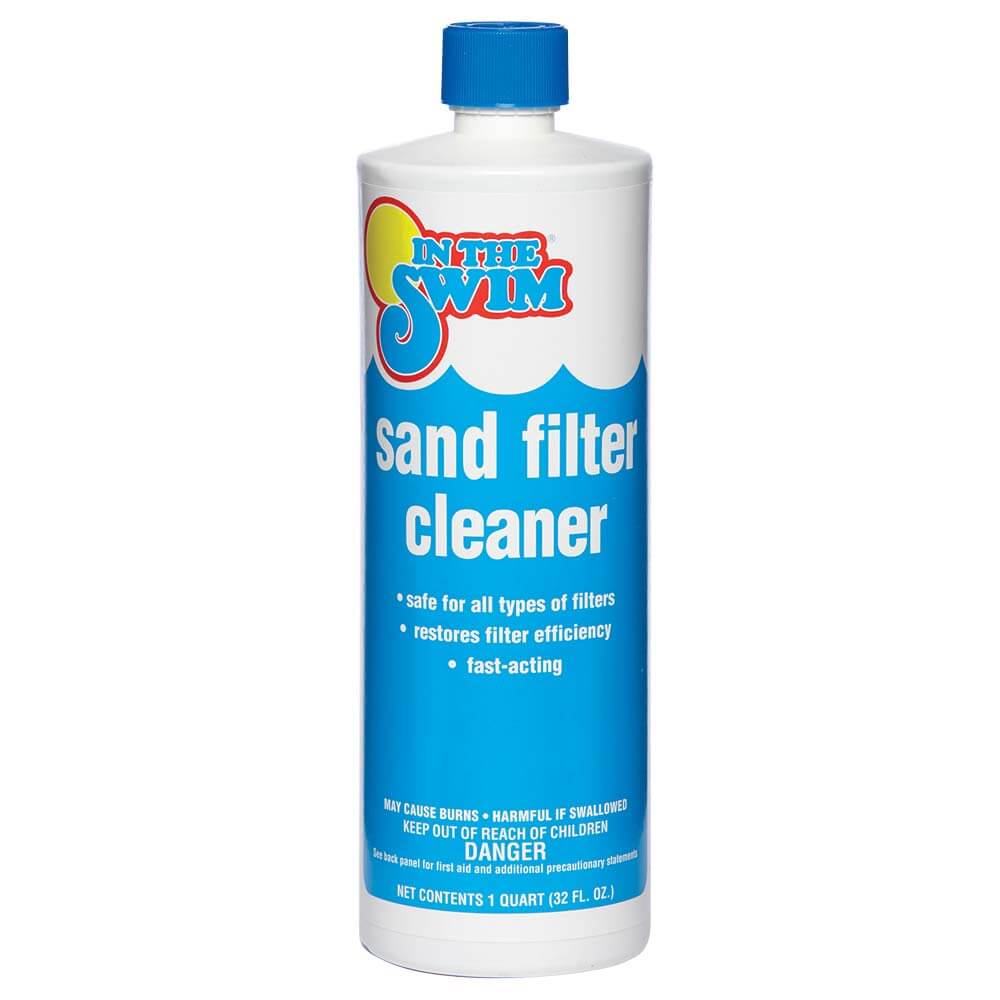
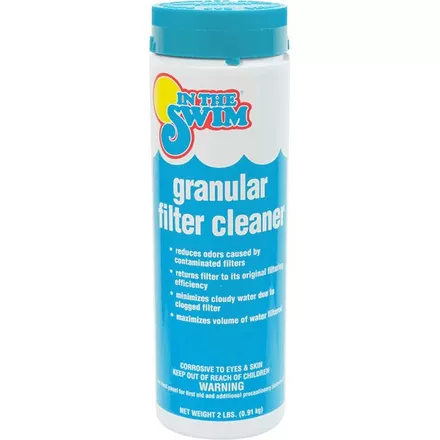
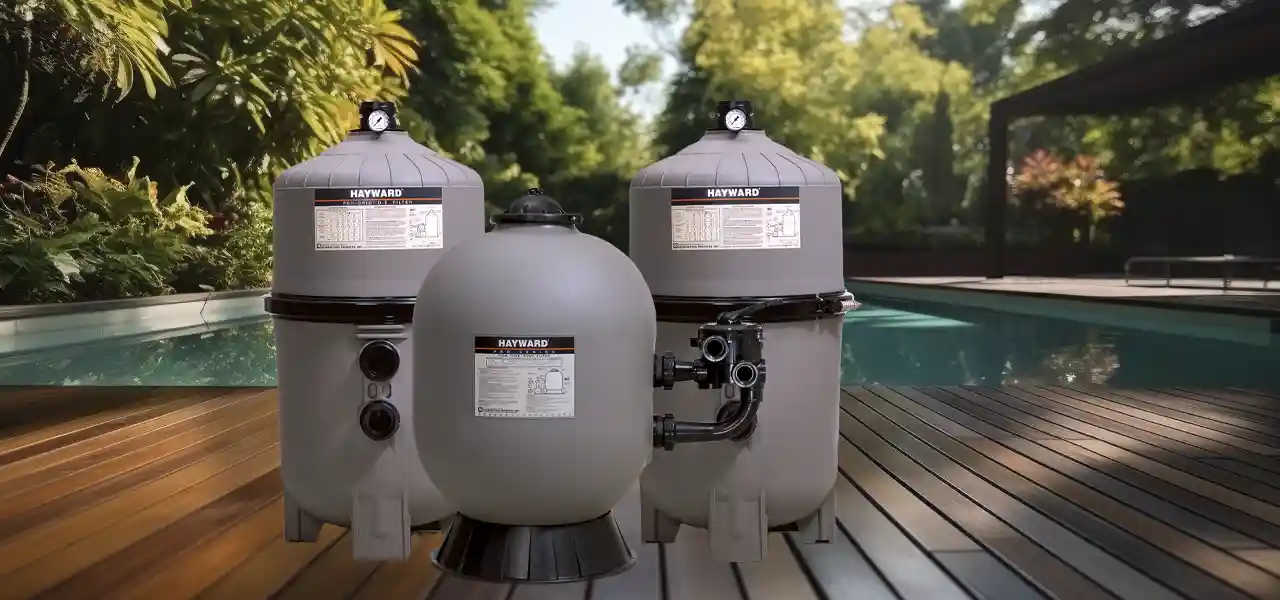
Davy,
Re gunite 30,000 gallon pool….After years of my psi running steadily at 10, it’s now running at 2 although at times it has shot to 10+ for a few hours before slipping back. I’ve checked all of the usual suspects (skimmer basket, impeller, gauge) and have backwashed frequently but no dice. Next step is to ascertain whether or not there is a leak In the skimmer line but given that there have been sporadic bursts of good psi, I wonder. I have a Cristal-Flo sand filter that is probably 25 years old and last time sand was replaced was probably 8-10 years ago. Any thoughts? Thank you very much.
Hi Bill, typically when pressure is lower than normal, that indicates an obstruction prior to the impeller. My first check would be to see if the impeller is clogged. Second would be to see if the skimmer line is clogged. Third would be an investigation to whether the skimmer line is collapsed. If the builders used Flex PVC pipe, that could be a possibility, see my other blog post on Sylvan Pool flex pipe skimmer repair. You can try to use a snake or camera cable to investigate. It is not a filter problem. It could be an air leak, if you notice a lot of air coming into the pump and pushing thru to the pool. This would also be found before the impeller, usually a loose pump lid, or loose fitting threaded into the pump, or leaky skimmer or main drain valves.
Davy – help! I have an earth filter, 36 with the Pentair multiport value. The pressure on the filter constantly goes up within half an hour of starting filtration, I backwash and rinse, and then start again. I have removed the grids, replaced them, cleaned them, changed the earth and power washed the grids more times than I care to admit! It just clogs up and the water return to the pool goes way down, pressure over 30. The water is clear, but it keeps clogging! I have changed the gauge too, to make sure it is not the problem. Any ideas? This is nuts to have to back wash every half hour or so!
Hi Larry, if the grids are not clogged with Oils and/or Scale (which can be removed with Filter Cleaner, or with TSP (for oils) and Acid (for scale)), and you have not replaced the pump with a version that pumps more (too much) water, I would look suspiciously at the DE powder, perhaps try a different brand. Assuming you are using 7 lbs of DE powder (when the filter is clean), or about 4-5 lbs after a backwash – and that the measurement of a ‘pound’ of DE powder is a 32 oz scoop, (not 16 oz, due to the fluffy nature of DE). Hope that helps?
First, thank you for your help. The filter casing won’t fill to the top. No clogs, replaced the casing gasket and filter basket gaskets, and applied lube. Impeller is clear and moves freely. No leaks. Another issue the system will pump fine with very few air bubbles in the filter basket, then it goes through a change where quite a bit of air gets in the system. I bleed at the start every time.
Thanks
Hi Scott, not sure if you mean the filter tank or the hair and lint strainer, but not necessarily a problem if either does not fill completely full, a little bit of air in either could be considered normal. As for the intermittent air in the pump, it could be a vortex in the skimmer, when the water level in the pool gets low, or it could be a stuck skimmer weir, or something else blocking the skimmer opening. Sometimes connecting a vacuum hose or suction cleaner can cause a pump to pull harder and this will create some air leaks that don’t normally exist. The same could happen if the skimmer or pump baskets become clogged. Hope that helps!
Hi Davy, I want to preface this by saying, “I don’t know what I’m doing.” I’m currently house sitting for a relative who was unexpectedly hospitalized. They have an inground pool about 22500 gallons. it was opened by pool professionals and they’ve been by a few times to help with my questions. My main one is that the filter psi varies greatly as the water rotates around the pool’s return jets. when it’s coming out of the jet at the deep end, which is closer to the pump and filter, the PSI is around 15-20, but when it’s at the shallow end, further away, it’s already up around 30 and that’s right after it’s been cleaned and new DE added, etc. The pool guys don’t seem to concerned about it and just tell me not to let it go above 30 PSI. but what does that mean!? on average? I’m terrified it will blow up or explode or break or do whatever pool filters do, on my watch. I can’t find a manual for the filter anywhere. It’s a Carvin Avalanche DE filter. it’s not on Carvin’s website tho the Sherlock looks similar. any advice you can send would be greatly appreciated.
Hi Julie, the Sherlock and the Avalanche are very similar if not identical. The fluctuation of the pressure may have to do with the setting of the return valves. If they are both open (deep and shallow), the pressure should be normal. Since the deep end is further away, typically a larger sized eyeball fitting is used on the wall return to balance the flow between the two. In lieu of that, the deep end return can be retricted slightly, by the valve back near the filter, to send more water to the shallow end, as needed. Generally speaking lower pressure is better, because it indicates higher flow. And when the pressure gauge is 7-9 psi higher than the starting, clean pressure after cleaning the filter and adding new DE powder, it is time to do it again, (backwash and add new DE powder). Also check the pump basket and the skimmer baskets periodically, as needed, to keep them clean.
I did have my basket backwards in pump and it stopped up with pine needles and I cleaned needles out and turned basket around right way but used to have 10 psi on filter now have 0 pump is pumping and water flowing into and out of pool just doesn’t seem to be filtering any suggestions. Thanks Kelly
Hi Kelly, if the water flow rate seems to be normal, but the filter pressure is zero… is the filter valve on the Filter position? Or possibly was moved to Recirculate? If not, then I would get a wrench or pliers and with the pump off, remove the pressure gauge and ream out the air bleeder assembly, where the gauge attaches, it may be clogged with debris. If that is not the case, there could be some damage to the filter valve (multiport) allowing filter bypass, either that or perhaps the impeller is still partially clogged.
Hi, I have a new hayward sand filter and 1.5hp pump on a 28′ round 52″ high pool. My psi when on filter is bearly above 0. If I plug the outlet, the pressure rises. It seems like flow is good, but I am suspicious that something is not right. To add to my suspicion, when I run the filter on recirculate, then I get 8-10 psi. Is it possible that the dial is really filtering on recirculate and recirculating when on the filter setting?
Hi Jim, yes that is backwards, you should see -0- psi on recirculate (and waste), and more back pressure on the filter setting. Is it possible that the filter valve was plumbed incorrectly? the pump should connect to the valve port labeled PUMP, and then RETURN port should of course connect to the return line. It could be possible that the valve was assembled incorrectly, with the diverter/rotor misaligned to the valve cover, but it would not be common. You can take off all the screws around the cover and spend some time inspecting how the rotor and lid are oriented to each other, and how different valve handle positions will result in flow going to the different “Multi” ports in the valve body. If you take it slow and look closely, you can figure it out – you da man! 🙂
Brand new pump attached to older sand filter. Water is pumping through but filter gauge is reading zero and water is dripping from joints around top of filter. I have bled the gauge but worried about keeping the pump on. Is this safe?
Hi Max, is the valve plumbed correctly? Is the port labeled PUMP connected to the pump? Unscrew the gauge and see if the area behind it is clogged. Gauge may be broken or the pump may be too large, if you upsized it, or changed make/model (not all horsepowers are equal). A pump that is too big for the filter is bad news, will give many problems. Water dripping from joints… did you use thread sealant, like Teflon tape?
Hello avid my new Hayward sand filter and 1hp pump pressure gauche is running between 10 and 15 psi .my pools was very dirty /green I backwashed a couple of timesbut the pressure gauge is still between 10 and 15 psi. is it “normal? Any suggestions? thank you very much .Tony
Tony, 10-15 psi is a good pressure, as normal as anything. If your pool is green, something is wrong either with circulation, sanitation or filtration. For circulation, does the pool circulate enough, and does it contact all of the pool? Cleaning the pool helps too, brushing, skimming, vacuuming. And running the filter long enough each day, in these hot July days, you need at least 12 hours daily pump run time, and during the sunlight hours too, so don’t try to run it only at night, or for just 8 hours per day, and at this point, if you are not already, run it 24/7, every day and night. Sanitation – high chlorine and low pH. Enough said. Filtration – again with the 12 hours daily minimum. Sand filters can also benefit from using a Clarifier, and using the Sand Filter Cleaner each time you backwash, and not over-backwashing. Wait until the pressure gauge rises, and the flow rate falls, before backwashing, because a dirty filter will actually filter the water better than a very clean sand filter.
Dave,
I have a 35,000 gallon in ground liner pool, 350 lb Hayward high rate sand filer and a 1.4HP pump. No problems for five years and now I cannot vacuum without the vacuum head sucking down. Back pressure on pump is down from normal 15 to about 12 psi and sand level is about 12″ from top of filter. Why do I seem to have higher flow rate this year?
It’s probably not a filter issue, but the vacuum head needs new brushes, the bristles having worn down, which puts the suction hole closer to the pool floor. In other cases, the floor is to blame, with uneven sand floor, high spots can cause a vac-head to get stuck. Or if you use a wheeled vacuum head, the wheel height is usually adjustable (on better models), and dropping the vac head, or loose screws, can push the wheels up, lowering the vac head closer to the floor.
Greetings Davy,
I have a real challenge for your expertise!! I have tried over the past several weeks to resolve multiple issues starting with the lack of prime.Tried shaving cream on all of the connections on both the low and high side of the pump. Finally located the leak on the low side repaired it; the basket is now full and air free with strong flow the 3 jets.
However, within 10-15 minutes my PSI increase from 12 PSI at start-up to 22 PSI and the 3 jets then have little to no trust. I spent 2 days rinsing and back washing with the same result.Thinking … with 8 year old filter grids that could be the problem! I purchased and installed a new outlet elbow ring and 8 new grid/filter screens for my Hayward DE 6020, added DE with the same results as above.
Where do I go from here?
Best Wishes,
Van
Hi Van, I’m going to suggest that maybe the DE powder may be to blame, if it is of low quality or a bad batch. Not something I have heard of before, but this year we have had numerous reports of bad filter sand, so the same “gremlins”, may be to blame for DE powder? I’m sure you are adding enough powder – remembering that 1 lb of DE is equal to 32 oz of dry measure, not 16 oz as one would think, but you have had this filter for many years, so that is not likely the problem. I could also suggest a bad gauge, but if your return flow volume is very low at 22 psi, then we can assume the gauge is correct. I’m a little stumped, so suggesting a different media (DE powder or alternative powder). Let us know how it works out!?!
Have in ground pool with DE filter, new pumps, both filter and Polaris vac. Nothing new added recently. For as long as I have had the pool, 20+ years, the normal pressure reading has been 15 psi. One day the pressure reading was 10 psi and has stayed that way. I replaced pressure gauge and air release valve. Have followed all of your suggested remedies. There doesn’t appear to be any loss of suction as the flow through the pump is normal, all returns and vac lines are normal. Polaris has no loss of power. When the vac pump is running , pressure drops about 2 psi to 8, then returns to 10 when off. There is a slight drip coming from a connection under the DE filter. No visible issues other than what I’ve mentioned. ?? Do I have a new normal or what else could it be. Thanks
Harvey, I guess if it ain’t broke… lower pressure is normally a clogged impeller or obstruction on the suction side, but that’s not the case here, and flow is not 1/3 less than it was either. Lower pressure can also come from less restriction on the return side, such as using different sized eyeball fittings, or no eyeball fittings, or removing a heater or chlorinator from the system, or adding a larger return side valve. Can’t think of anything else, may be the new normal?
Hi,
I have ED filter. When the system is clean and backwashed the pressure runs at 6-8 PSI. After I back wash I tend to add 3.5 scoops of DE. Last year it would take 60 to 90 days for PSI to reach 15-20 PSI Which meant time to clean. This early this year I started to notice that its takes only 2-3 weeks to go from 7 psi to 20. It kind of worries me a little bit. Any suggesting on what I should I be looking to into?
Hi Luis, the length of a filter cycle does indicate something, so you are right to wonder about it. The grids themselves could be clogged with oils and/or scale, which can be removed by soaking in a DE Filter Cleaner. Using most Clarifiers can also gum-up DE filters, so should be avoided, when possible. Could there be some other changes to water chemistry, or external effects of extra pollen or nearby dust or sun tan lotion this year? It could also be bad DE powder, of a lesser quality, or not quite graded right or something, if you are using a new bag this year.
I have an inground gunite pool with sand filter. When the pump is on, it takes over 1 min to get to full suction thur the skimmer even after the pipes have been primed and all air let out. There is maxiumum flow thru the skimmer and out from the return jets. PSI at 12. However, about 15-20 secounds afterwards, the PSI drops back to almost 0 and flow is slowed to almost a stop.
Is this normal that it runs in cycles?
If not, what is wrong and what should be done to fix it?
Lee, not normal. It could be air coming from low water level, or stuck skimmer weir, leaky valves, loose pump lid, loose pipe coming into pump…
De filter 48. Always worked good. Now my filter pressure starts at 12 use to start at 10. And in 35 -40 min. Gauge reads 25. And water pressure has slowed down. I soaked my filte grids and it still happens
John, I would soak the grids again, either in DE Filter Cleaner, or soak in TSP to degrease, followed by a 10% acid solution soak, to descale – there must still be either scale or oils, or both clogging the fabric. Or replace the grids if they are near 10 years old. Are you using enough DE powder? Remember that 1 pound of DE powder is not 16 oz dry measure, but actually 32 oz dry measure.
My pressure gauge got broken and i ordered a new one but 2 days before its here. Can i run the vaccuum wothout yhe gauge w/out damaging anything. I just got the water balanced and used algevide and want to get the remnants up before they disburse again?
Kris, yes absolutely. The gauge tells you how clean the filter is, but won’t affect the pool cleaner.
I have a hayward 1.5HP, filter holds about 60 pounds of crushed glass. Above ground pool and with 1 1/2″ PVC hardpipe. There is a small amounbt of air in the top of the pre-filter (right before the pump) and when the pump shuts off there is enough back pressure that water rushes backwards and blows the skimmer off. Filter pressure is 12PSI. I used a filter media clean a few weeks and back wash weekly.
The problem is an air leak in the pump. BEFORE the pump, air is entering the pump, and building up. Find the air leak and seal it up, and you will fix the problem.
I purchase a new Hayward extreme 1.5hp pool filter. The first time I ran it the gauge read 20psi. It ran great for only a couple of days. Then I cleaned the filter place the filter back in and started it and it read 20psi. After 1 hour the psi went to 23psi. The return flow was weak. This continues to happen. It’s been three weeks and I can’t get the pool clear. I have to clean the filter several times a day. Any suggestions.
Hello James, so the pressure rises and the flow slows… sounds most certainly like a dirty filter, or more specifically a filter clogged with oils or scale, most likely an oily substance. Soak the cartridge in TSP or Pool Filter Cleaner for a few hours and then return to the tank.
My psi when the pump is on high is at 15 and about5 on low. Is that normal?
Yes that could be normal. All pool systems have slightly different pressures.
I have a new build Inground gunite pool. I have cleaned the cartridge filter with flosser and spray cleaner. However psi is still 35, the first 7-10 days the psi was around 18. I cleaned the pump strainer and closed everything up and it jumped to 35. Have cleaned filter twice and still in 35 range. My PB said maybe that’s more Accurate operating range. That doesn’t seem right to me
Hi James, yes does not sound right to me. 35 psi is fairly high pressure for a filter system. Remove the cartridge, and see what the pressure is? If very low without the cartridge, soak the cartridge in Filter Cleaner chemical, rinse and reinstall, thinking the cartridge may be clogged with oils or scale, or both. If pressure still high, replace the cartridge. If pressure is still elevated without the cartridge, look down the line, is there a valve partially closed? Is there an obstruction in the return pipe? Do you have a heater with a bypass assembly installed?
I recently bought a brand new pool pump, after backwashing/cleaning filter I get good pressure from skimmer n return after abt 45min to an hour pressure goes away in both. Pressure on gauge starts around 18 psi. Any suggestions?
That’s a filter problem. Either the filter media (cartridge or sand) is in bad condition and should be replaced or you can try to use a pool filter cleaner chemical to remove the oils and scale from the filter.
I can’t get my DE above ground pump filter to maintain high pressure for more than 20 minutes. Water is greenish and cloudy. No idea what’s on the bottom. New house and the pool hasn’t been opened in 6 years since the previous owners ran it. I keep bumping the filter and backwashing and even opening the Hayward filter up to power wash it. Totally clueless at this point. Don’t seem to be making progress.
Hi Jase, keep at it. Here’s some tips. Keep the chlorine high (3-5 ppm) and the pH low (around 7.2). Run the filter non-stop, 24/7. Clean the filter in a 5-gal bucket of warm water and 1 lb TSP. Rinse well, and then recharge with DE powder, remembering that 1 lb of DE powder is 32 oz of dry measure, not 16 oz like one may think. A little non-polymer Clarifier like SeaKlear 4-in-1 or enzymes can be used.
I have 2 fountains and 2 return jets. The piping from my filter is split into 2 with each having a valve to control the above. Last year we could keep the valve to the return jets wide open and open the fountain valve slightly to turn them on. When I do now, my pressure jumps 20+psi and I turn it off. If I close the retuen valve and just have the fountains on, pressure is normal at 10 psi. Any idea why?
Cody, that just doesn’t make sense, that opening the wall returns will result in higher pressure, and closing them, and using just the fountains would give lower pressure. It should be the opposite. Therefore, I sense that the valve diverters may not be in the position you think they are in? Or something else is incorrect?
Pool is clear. Filter pressure goes from 10 to 20 in a couple days after backwash. I have a sand filter and replaced sand last year. The water in the returns barely comes out so I have to backwash to get water moving. Any idea of why that is happening?
Hi Terri, the filter may be gummed-up, with goopy gunk! Try a Sand Filter Cleaner, or you can use some TSP, letting it soak inside of the tank for awhile. You can also remove the valve or dome, and put a garden hose into the sand bed, pushing it deep into the sand to irrigate. Dig your hands in there to loosen ‘grease balls’ and ‘sand chunks’. Let the tank overflow from the top, onto the ground (shield the pump motor from falling water). Check the level to be sure it’s all still there, the sand. Should be about 2/3 full, for most filters.
Opened my pool and it was really dirty this year, changed the sand in the filter. I’ve backwashed it 4 times, and after I do that it runs at 10 psi for a few hours and everything is fine. Then after a few hours pressure is up to 20, water is slow coming in the return line and the suction at the Skinner box is slow. Why does this keep happening?
I would suspect that you have a pretty small filter, is that right? Small sand filters work well for clear water, but can choke during times of adverse water conditions. Just keep backwashing as needed, and if you use a Filter Cleaner before backwashing it can help flush out the oily gunk. Are you backwashing long enough? 2-3 minutes is usually fine for small filters. You can also remove the top and use a garden hose to flush out the sand, sticking the hose deep into the sand in many locations, and letting the tank overflow. Good for getting those gunky grease balls out of the sand
I’m having same issue. Any luck with yours
Pool is clear. Filter pressure goes from 10 to 20 in a couple days after backwash. DE grids were changed last year. Air release valve replaced last year. I have read breather valve may be clogged. Is that a possibility and what else could be the cause? Thx.
Hi Rob, probably not the breather valve, but most likely the grids are clogged up with oil or scale or both. Soaking the grids in a DE filter cleaner, or in a TSP solution (for oil) and/or an acid solution (for scale) would be recommended. Also be sure to use the correct amount of DE powder, which you probably are, keeping in mind that 1 lb of DE powder is actually 32 oz of dry measure.
Usually when I start my pump and release the relief valve on the filter, pressured air and then water comes out and I closer her up. This time, no pressure and just a little water comes out. Pool is running at correct psi, water is discharging into the pool good, pump is running ok. Is this alright? Just the first time this has happened so checking
Lisa, the assembly is probably clogged. You can either remove the bleeder knob completely (on some models), or unscrew the pressure gauge to allow the clog to blow out. In rare occassions, you may need to use a small pick to help unclog the air bleeder assy.
I recently changed the sand in my filter (following manufacturer steps) and now my pressure gauge doesn’t move however, the pressure of the water coming into the pool feels the same. Prior to changing the sand, the pressure was 20psi. I replaced the gauge, dismantled the 7 position valve and checked all seals, and verified there are no leaks anywhere in the system. I also verified that the center pipe in the filter is sitting directly on the bottom, is free of debris and is fitting into the bottom of the 7 position valve correctly. I can only get the system up to 10psi (half of what it used to be prior to the and changes) is to switch my pump to it’s highest speed setting. What else can I check?
Frank, might be no problem?!? New sand can often allow better flow, with reduced pressure. Perhaps the old gauge was wrong, or perhaps the new gauge is wrong. Or the underside of the gauge may be clogged, or covered in Teflon tape (done that one before myself). Unscrew it and make sure there is not a plug of debris underneath. Gauges only cost $10, so we shouldn’t put all of our faith in them! As long as the flow rate seems normal, don’t lose any sleep over it!
I put a new gauge on yesterday being very careful with the Teflon and it still shows no pressure but when I put my pump on the fastest speed, it only goes up to 10psi. I know it’s working because all settings on my valve function. I’m just concerned that it’s not functioning efficiently. I’ll let it go for a few weeks and see if the pressure increases from zero over time as more debris is sucked in.
Frank, on low speed, it is not uncommon for pumps to show no pressure or very low pressure. 10 psi is normal or usual for most pool systems, when pumps are running on high speed.